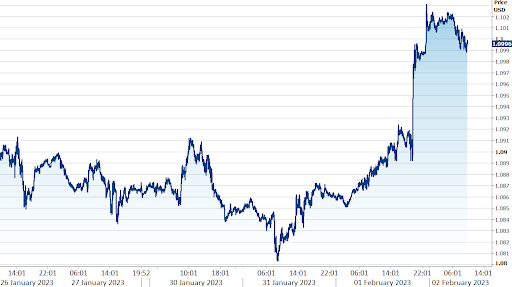FOMC February Meeting Reaction: Dollar sinks on Fed’s disinflation view
- Go back to blog home
- Latest
In line with our expectations, Fed chair Jerome Powell delivered a dovish shift in his communications following Wednesday’s FOMC meeting.
Investors perceived Powell’s press conference as far more dovish than the statement, which can explain the market reaction, although we believe that his comments were largely consistent with market pricing. As we indicated would likely be the case in our FOMC preview report, Powell refused to declare victory over inflation just yet, saying that the job was ‘not fully done’. He also stressed that the Fed would need ‘substantially more evidence’ to be confident in the path of inflation, specifically highlighting the ‘core services ex-shelter’ component of the index as the key indicator to watch, as this is the area yet to show signs of disinflation.

His communications were laced with a handful of dovish remarks. During the press conference he said that the Fed has ‘no incentive, desire to overtighten rates’. For the first time, Powell also explicitly indicated that the disinflationary process had begun. His comment that it would take some time for rate hikes to filter through to the economy may also partly explain the sell-off in the US dollar, as could Powell’s lack of endorsement for the December ‘dot plot’, which had the terminal rate higher than currently priced in. This was enough to send the dollar almost 1% lower against its basket of major currencies, with EUR/USD jumping back above the $1.10 level for the first time since April.
Figure 1: EUR/USD (1 week)

Source: Refinitiv Date: 02/02/2023
We believe that the Fed is beginning to lay the groundwork for an end to its hiking cycle, although for now it appears to be keeping its options open. For risk of deviating from the bank’s December rate projections, Powell noted that a ‘couple’ more rate hikes were on the way, without explicitly stating whether that included this week’s rate increase.
This wasn’t enough to convince investors that the Fed intends to stick by its recent ‘dot plot’, which pencilled in a terminal rate above 5% in 2023. At the time of writing, futures markets are pricing in an 85% chance of another 25bp move in March, and only around a one-in-five possibility of an additional one in May.
Following Wednesday’s announcement, we maintain our view for a final 25bp rate hike at the Fed’s March meeting, at which point we expect the bank to hint that it may pause its hiking cycle. Clearly, the Fed does not want to pre-commit to this just yet, nor did we necessarily expect them to, particularly given uncertainties surrounding inflation. We believe that Powell’s comment on the beginning of disinflation are, however, a key indication that a pause is imminent, and that this could come as soon as the next meeting. Upcoming US inflation prints, particularly the core index, remain key. As has been the case for some time, we expect volatility in markets to be heightened surrounding their release.

